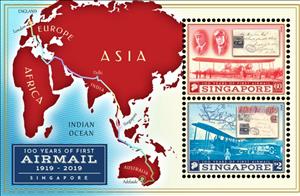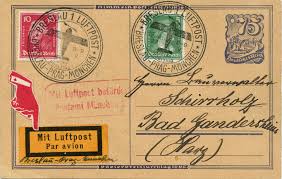Souvenir Sheet: Centenary of First Airmail Flight to Singapore (Singapore 2019)
Centenary of First Airmail Flight to Singapore (Singapore 2019)
31 July (Singapore ) within release Centenary of First Airmail Flight to Singapore (2019) goes into circulation Souvenir Sheet Centenary of First Airmail Flight to Singapore face value 2.60 Singapore dollar
| Souvenir Sheet Centenary of First Airmail Flight to Singapore in catalogues | |
|---|---|
| Colnect codes: | Col: SG 2019-09 |
Souvenir Sheet is horizontal format.
Sold by Singapore post for SG$2.75Also in the issue Centenary of First Airmail Flight to Singapore (2019):
- Souvenir Sheet - Centenary of First Airmail Flight to Singapore face value 2.60;
- Stamp - Centenary of First Airmail Flight to Singapore face value Variable;
- Stamp - Aircraft and Cover from Flight face value 2;
- Stamp - Flight Pilots and Cover from Flight face value 60;
- Souvenir Sheet - Centenary of First Airmail Flight to Singapore face value 2.60;
- Stamp - Centenary of First Airmail Flight to Singapore face value 60;
- Stamp - Centenary of First Airmail Flight to Singapore face value 2;
Souvenir Sheet Centenary of First Airmail Flight to Singapore it reflects the thematic directions:
An aircraft (pl. aircraft) is a vehicle that is able to fly by gaining support from the air. It counters the force of gravity by using either static lift or the dynamic lift of an airfoil, or, in a few cases, direct downward thrust from its engines. Common examples of aircraft include airplanes, rotorcraft (including helicopters), airships (including blimps), gliders, paramotors, and hot air balloons.Part 1 (Definitions and Abbreviations) of Subchapter A of Chapter I of Title 14 of the U. S. Code of Federal Regulations states that aircraft "means a device that is used or intended to be used for flight in the air."
A map is a symbolic depiction emphasizing relationships between elements of some space, such as objects, regions, or themes. Many maps are static, fixed to paper or some other durable medium, while others are dynamic or interactive. Although most commonly used to depict geography, maps may represent any space, real or imagined, without regard to context or scale, such as in brain mapping, DNA mapping, or computer network topology mapping. The space being mapped may be two dimensional, such as the surface of the earth, three dimensional, such as the interior of the earth, or even more abstract spaces of any dimension, such as arise in modeling phenomena having many independent variables. Although the earliest maps known are of the heavens, geographic maps of territory have a very long tradition and exist from ancient times. The word "map" comes from the medieval Latin Mappa mundi, wherein mappa meant napkin or cloth and mundi the world. Thus, "map" became the shortened term referring to a two-dimensional representation of the surface of the world.
Postal history is the study of postal systems and how they operate and, or, the study of the use of postage stamps and covers and associated postal artifacts illustrating historical episodes in the development of postal systems. The term is attributed to Robson Lowe, a professional philatelist, stamp dealer and stamp auctioneer, who made the first organised study of the subject in the 1930s and described philatelists as "students of science", but postal historians as "students of humanity". More precisely, philatelists describe postal history as the study of rates, routes, markings, and means (of transport).



